The Google Nexus 5X Review
by Brandon Chester on November 9, 2015 8:00 AM EST- Posted in
- Smartphones
- LG
- Mobile
- Android 6.0
- Nexus 5X
Display
A smartphone's display is unquestionably one of its most important aspects, and failing to deliver a good display can be a fatal flaw for a device. If the screen doesn't have sufficiently high brightness and contrast then its usability with high ambient lighting will be severely crippled. Inaccurate color rendition will cause photos and videos that are taken and viewed on the device to look radically different from other devices. Pushing a wide color gamut can also have ramifications that go beyond making the display inaccurate, such as reducing battery life on AMOLED devices by having to drive a higher voltage in order to achieve the wider gamut.
Last year's Nexus 6 ended up being a significant disappointment as far as the display was concerned. It was immediately obvious to me that the gamut was far too large, and that peak brightness was too low. My testing confirmed both of these things, and I was disappointed mainly because the Nexus 5 from the previous year sold for significantly less than the Nexus 6, and sported imperfect but relatively good display calibration. While this year's Nexus 6P is an AMOLED display that we are yet to test, the Nexus 5X sports an IPS LCD like its predecessor. At 5.2", this year the display is a bit bigger than the 4.95" Nexus 5, but it's still a far cry from the 5.96" display that was on the Nexus 6.
To analyze the quality of the Nexus 5's display I've run it through our standard display testing suite. As always, displays are calibrated to 200nits of brightness, and results are measured with an i1Pro 2 spectrophotometer, and managed using SpectraCal's CalMAN 5 software. Contrast measurements are done with an i1Display Pro colorimeter due to the i1Pro 2's more limited accuracy with very low brightness levels.
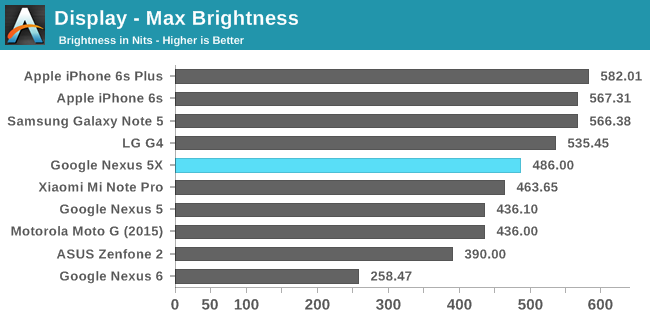

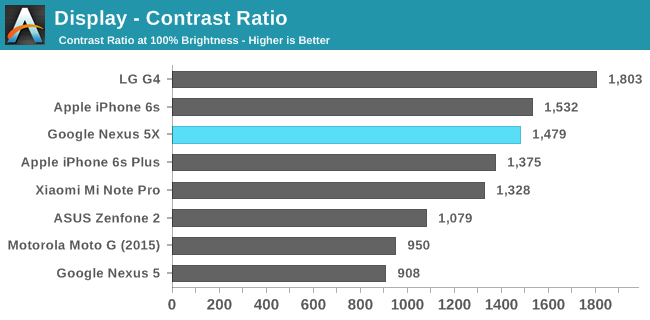
The most basic data point to examine when moving beyond resolution is a display's maximum brightness and its contrast ratio. The Nexus 5X does very well here, with a peak brightness of 486 nits, and a minimum black level of 0.32 nits, which leads to a contrast ratio of 1479:1. This is the result of the use of photo-alignment to influence subpixel orientations and reduce light leakage, which results in deeper blacks and thus a higher contrast ratio. While many other LCD-based smartphones are also using this technology, to see it applied to a $379 smartphone is very exciting. The display's maximum brightness is also a healthy improvement over the Nexus 5, and I haven't run into any situations where the display can't get bright enough to counter glare from the cover glass.
Something that doesn't really show up in any of our figures is the visibility of the display's capacitive sensors. On the Nexus 5 these were fairly noticeable when there was any light shining on the display, and this is unchanged on the Nexus 5X. This is something that can be observed on every device with capacitive touch, although on AMOLED devices and iPhones it's extremely hard to see. I only felt it was worth pointing out because it does seem more pronounced on the Nexus 5X than some of the other devices I have.
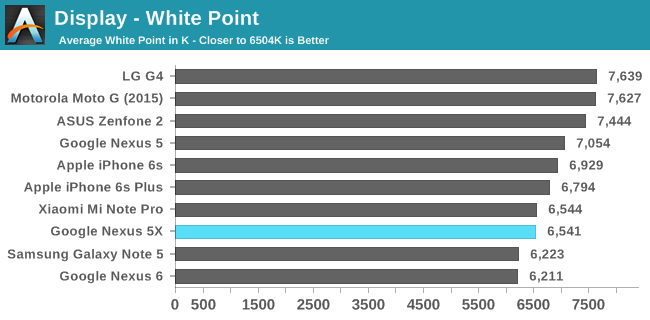
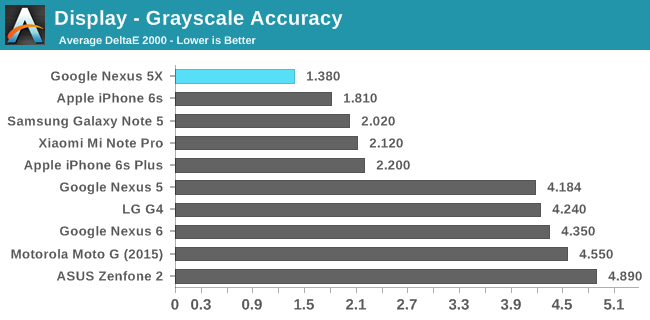
Greyscale accuracy on the Nexus 5 is impeccable. Gamma does tend slightly upward as one moves past the 20% mark, but it's still quite accurate and most greyscale errors are approaching the point where the human eye could not even distinguish them from their reference colors when placed side by side. The RGB component balance for each shade of grey is also very good, and the display's average white point is only ever so slightly above the targeted 6504K. There's not much more to say, as this level of calibration is exceptional for a device of this price. The Nexus 5 certainly had fairly good calibration, but issues with the gamma made the display appear washed out which was a common complaint, and the Nexus 5X resolves that while also boosting accuracy significantly.
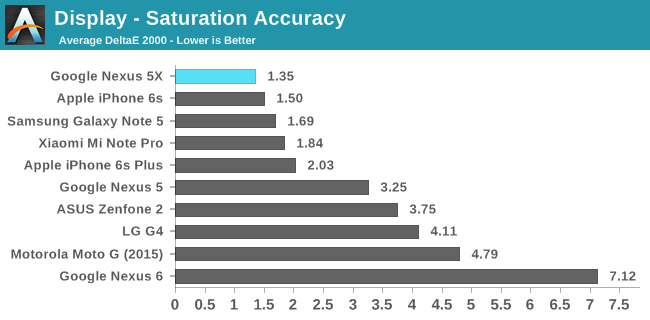
The accuracy for 20% saturation steps on the Nexus 5X is also incredibly high. It's actually the lowest DeltaE on record for a smartphone - lower than even the Galaxy Note5 and iPhone 6s - and there's honestly nothing at all that I could criticize about the rendition of primary and secondary colors on the display. The chart above also shows how much improvement has been made compared to the Nexus 5 and Nexus 6, with the latter being especially bad due to its overly wide gamut.
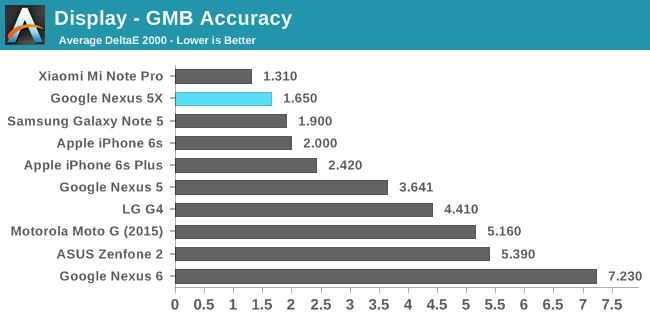
Once again the Nexus 5X provides an incredibly high level of accuracy, with color mixtures being reproduced almost as accurately as primary and secondary colors. It's not the absolute best result on record due to the Mi Note Pro's even higher level of accuracy, but you would only be able to tell that the rendition is wrong if you had the color right beside the reference color with absolutely no motion occurring, and that's well beyond the level of accuracy that is really necessary for a mobile device.
I really don't know what else to say about the Nexus 5X's display, because there's really nothing that can be criticized. I would certainly like if the brightness went up to 600 nits, but I would also prefer that it went to 6000 nits, and obviously that's asking a bit much. As far as LCDs go, the Nexus 5X has one of the best, if not the best that I've seen to date. At this point Google and their OEM partners are going to have to look to gamut as a vector of improvement, but only after proper color management is available at the OS level in order to avoid the problems that have plagued wider gamut displays, which have lacked suitable color management to properly map sRGB content into the wider color space.


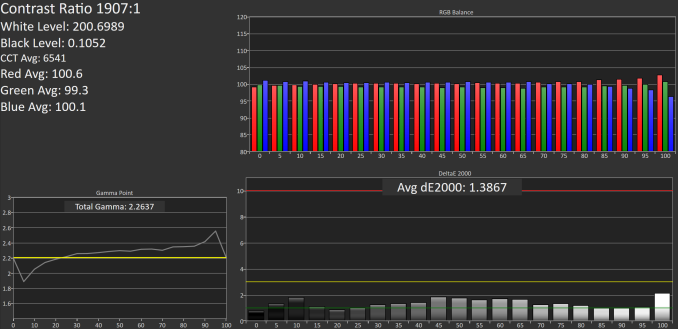
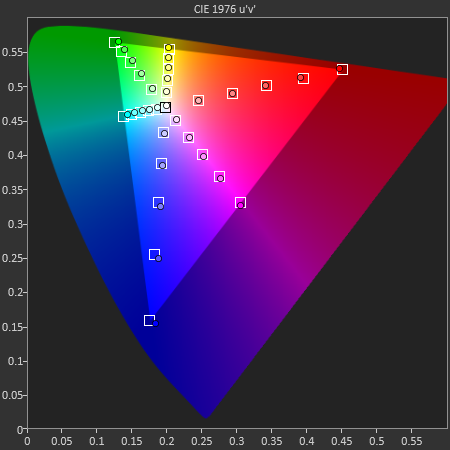









197 Comments
View All Comments
Jojo99 - Monday, December 21, 2015 - link
Do you by chance have a 16GB model? And is everything lagging?I have a 32GB model and don't really notice any lagging at all. Don't have any lock-up problems either.
The camera is better than the Nexus 5 but still not great, especially in low light. Lot of noise. Highlights also often get blown out. Trying to understand why I am seeing EXIF info of ISO 60 in low light. Doesn't make sense.
Also like the LG Nexus 5, if you take a camera shot where the sun is in the frame, you'll get a small blue or green spot in the lower part of the shot.
The camera definitely not anywhere as good as my friend's iPhone 6 camera or my 8 year old Canon point and shoot..
Aloonatic - Tuesday, January 12, 2016 - link
I have the 32 GB model and it stalls, locks up, freezes, lags and apps crash often, with most apps I use, and when navigating system menus too.Performance wise, with general use, it's really no improvement over my 1st gen Moto G!
I've found that I've restarted this phone several times, 3 or 4 times a week at least. I wish I'd seen some of the comments here before buying one.
Aloonatic - Tuesday, January 12, 2016 - link
Why didn't I see your comment before I got one.I have no idea about the Nexus5 but my 5x has been a bit of a nightmare, and I replaced it as my Moto G was too slow and laggy, which I put down to it being 2 years old and lacking RAM, this is no better.
flyguy29 - Thursday, December 24, 2015 - link
I was under the belief that the Nexus devices were the flagship statement Google - collaborated smartphones... It's positioning as a "pure android" experience still does not address key touch points in overal consumer targets. But at least the mission statement is clear- a pure Android experience without any pretenses about superior screens, camera, etc- it's all about the fundamentals of a smart phone's functions and how a user engaged themAloonatic - Tuesday, January 12, 2016 - link
I got one of these after my 1st Gen Moto G started flagging and, frankly, I don't notice a great improvement in performance.-Sure, screen is bigger but the Moto Gs might have been small but it looked pretty good.
-The finger print senor is handy...
-However, it still stalls on unlocking all the time.
-Just trying to send a message can take 10s of seconds, and the keyboard often appears so you type, nothing happens, and then half a sentence appears in rapid fire.
-Switching between apps is still far too slow, and seems as slow as with my Moto G to me.
All in all, not a great deal of improvement over a cheap phone from a couple of years ago, which is pretty pathetic really, and seeing as this phone has more RAM and more horsepower under the hood you have to point the finger at Android OS itself, as others have mentioned.
blzd - Tuesday, January 19, 2016 - link
No performance issues on my 5x, runs as smooth as my N5 and gaming is not only faster, but the device runs considerably cooler while doing so.The camera and battery life are also big improvements over the N5.
If you have performance issues with your 5x look to your apps and services as the cause. Apps like Tasker and Snapchat have been known to be an issue. Also some users had issues restoring from a previous device and were able to resolve them by a factory reset without restoring.
Aloonatic - Sunday, February 7, 2016 - link
All I can say is that the N5 must have been terrible. Honestly, I have no axe to grind here(I've gone for a straight Nexus phone as I've tried every manufacturer out there and not been too impressed) , but this phone feels like a huge mistake to me.I am used to the normal smart phone cycle. 1st 6 months, great, everything is gravy. Then 6 to 18 months, it get gradually worse. THen the last 6 months are a grind where all you want to do is smash your phone into a million pieces as it's so slow and useless (even with factory resets etc, I'm not a muppet)
This phone feels like it's in the mid part of that cycle, so god knows what it'll be like at the endof my 24 month contract.
The battery is woeful, and I'm hardly a power user. I had to buy a car charger just to make it last the day.
I have only a handful of apps installed and they are all from major players, not a load kids making apps for fun and releasing them.
I have to power-cycle it multiple times each week.
It lags, it's slow, it's a mess.
Then the finger print scanner doesn't always work ,and the day dream mode fails all the time so it can't even work as a bed side clock when on charge any more.
It is no faster or smoother than my 2 year old Moto G.
Not worth the money.